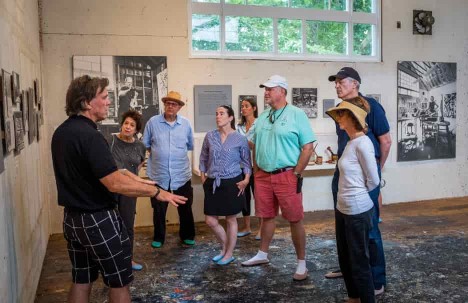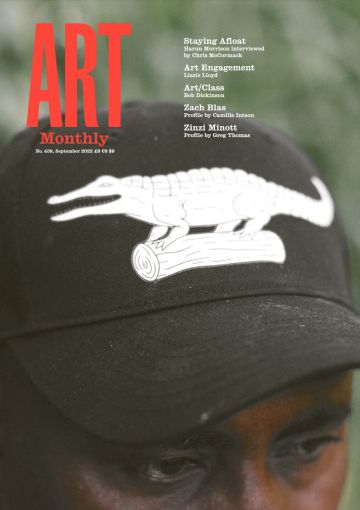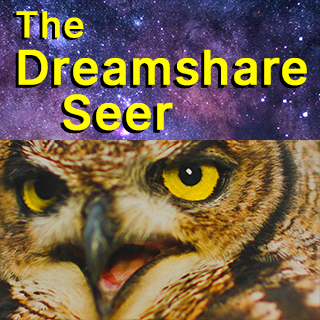Report
Letter from the Hamptons
Daniel Neofetou on an East Coast culture clash

visitors to Jackson Pollock and Lee Krasner’s barn
Since the pandemic-induced permanent migration of affluent New Yorkers to what were previously their summer residences in the Hamptons, there has been an efflorescence of commercial galleries among the Long Island seaside communities. The majority of these are the kind of mid-market galleries that have no qualms about the fact that they are shops, and unashamedly display the price tags of the works on their walls. However, a few blue-chip establishments have also recently opened outposts in the Hamptons, among them Pace and Hauser & Wirth, and it is remarkable how much they have opted to resemble the gaucheness of their more provincial counterparts.
This is most egregious in the case of Pace in East Hampton, which is currently exhibiting a show mainly consisting of artists who are historically significant but have previously been somewhat overlooked (by collectors), including Roberto Matta, Wilfedo Lam, Louise Nevelson, Heitor dos Prazeres and Richard Pousette-Dart, peppered with a number of contemporary artists who essentially deliver simulacra of the previous artists’ styles. The curation of the show is clearly dictated by the inventory available, and the works are not positioned in any kind of productive dialogue, but instead appear as a selection of commodities. It is jarring to see canonical 20th-century artists in such an unabashedly retail setting.
Camille Henrot’s exhibition at Hauser & Wirth in Southampton, while still pervaded by the same ambience, is more of a coherent show. In it, the French artist continues to plough her furrow of Modernism after the internet, most excitingly in terms of a number of bronzes in a sculpture garden behind the gallery, especially one that incorporates the folded paper icon familiar from Microsoft Word documents on its plinth.
What is most remarkable about both galleries, however, is the fact that it is possible to walk, unattended, around a corner (in the case of Pace) or upstairs (in the case of Hauser & Wirth) straight into the gallery’s viewing room, where clients are conventionally taken to see pieces not on show to the general public. As is the case with all blue-chip spaces, the viewing rooms in branches of Pace and Hauser & Wirth are usually hidden away from art lovers who can’t spare a few tens of thousands of dollars on a Matta crayon and graphite drawing or curious visitors who have walked in off the street. In Southampton and East Hampton, however, every punter who chances through the doors is a potential client (outside both galleries there are racks of free magazines, one of which is a real-estate brochure listing properties priced up to $45m) so the viewing rooms are just continuous with the exhibition.
Both viewing rooms are also disarmingly domestic, with sculptures by Louise Bourgeois and paintings by Robert Motherwell and Lee Krasner, which presumably cost millions of dollars, installed next to coffee tables and comfy chairs. I have never seen anything which exemplifies Harold Rosenberg’s dismissive description of Abstract Expressionism’s ossification as ‘apocalypse wallpaper’ as much as these canvases tastefully hanging in shadow box frames.
For the experience of works by Krasner and her husband Jackson Pollock (as prints, aside from one original late 1930s painting by Pollock) in a very different domestic setting, East Hampton is also home to the Pollock-Krasner House and Study Centre, where the couple lived from 1945. With the exception of an outhouse gift shop, where it’s possible to purchase Pollock mouse mats, watches and a recipe book featuring ‘Jackson’s famous spaghetti sauce’, this historical attraction places admirable accent on the historical, no doubt thanks to its erudite director and tour guide Helen A Harrison. With the exception of revolving exhibitions on some of the front room’s walls (at the time of my visit there was a display of decidedly unarresting paintings by Krasner’s protégé Terence Netter), the house is exactly as it was when Krasner died in 1984, down to the couple’s collections of records and books.
Of course, the main draw is the legendary barn in which Pollock spent 1946 to 1952 working on his seminal drip paintings. The baroque mess Pollock left while making art history is still there, preserved under flooring which was laid down when the barn was winterised after this period. It is absolutely thrilling to see and walk across these remnants and by-products of iconic 20th century works (wearing protective booties). Recently, however, the Pollock-Krasner House has seen the addition of a virtual reality experience, wherein visitors can opt to don headsets at the end of the tour while sitting on stools in the house in order to explore the barn in which they were just standing as it was when Pollock worked in it, and subsequently as it was when Krasner took it over and produced her own violently rhythmic mural-sized action paintings.
While it might arouse scepticism as an unnecessary gimmick, a particularly novel aspect of the VR experience illustrates precisely where particularly famous works by each artist were made. In the case of Pollock’s paintings, this means that it is possible to walk onto them. Paradoxically, standing within Blue Poles in virtual reality, the painting seems more alive than I imagine it would if the real thing were neutered in a commercial gallery’s viewing room (a fate which it will presumably never meet, since it is the prized possession of the National Gallery of Australia).
To see some paintings that never had any vitality to lose in the first place, one might head to the current exhibition at Water Mill’s Parrish Art Museum, in which hang a number of canvases by Torkwase Dyson. Albeit with a darker palette, the loose thin geometrics of her recent works most readily call to mind the so-called zombie formalism of younger and mostly male artists that commanded the market in the mid 2010s, especially the paintings of former wunderkind Christian Rosa (who has recently been indicted by the FBI for forging Raymond Pettibons). Observing Dyson’s canvases, I couldn’t help but think of Fredric Jameson’s description of postmodernism as the depthless imitation of dead styles. And perhaps this is the point. But the show of which they are a part – ‘Set it Off’, curated by Racquel Chevremont and Mickalene Thomas – also features works that negotiate deadness in far more affecting ways, especially a remarkable installation by February James named These Are My Ghosts to Sit With, 2022, and two sculptures by Kennedy Yanko, Wading the Storm, 2022, and In the Whole World Together, 2022.
These Are My Ghosts to Sit With consists of a table and chairs caked in pigmented paper pulp and acrylic, overseen by a similarly coated China cabinet, upon which is painted the dysphoric visage of one of James’s signature portraits. While the found furniture is certainly older than the fresh papier-mâché, the latter weighs on the former like centuries of dust, separating the work from the spectator with obstinate impenetrability, but in spite of, or perhaps due to this distance, the installation bears a distinct melancholic heaviness.
Whereas James’s installation evokes mortality with the material of carnival pageantry, Yanko’s sculptures threaten to burst with life despite being made from the twisted metal familiar from refuse. Two are suspended from the ceiling, and one is balanced on a single point, decorously cloaked in soft paint skin. They appear both extremely restrained and ostentatiously obnoxious, as if they would be running riot around the gallery if it weren’t for the fact that they were being held back by an invisible force. It is rare for art to cultivate such an acute sense of a pregnant moment; truly a (newer) Laocoon for the 21st century.
Daniel Neofetou is the author of Rereading Abstract Expressionism, Clement Greenberg and the Cold War, Bloomsbury, 2021.
First published in Art Monthly 459: September 2022.









